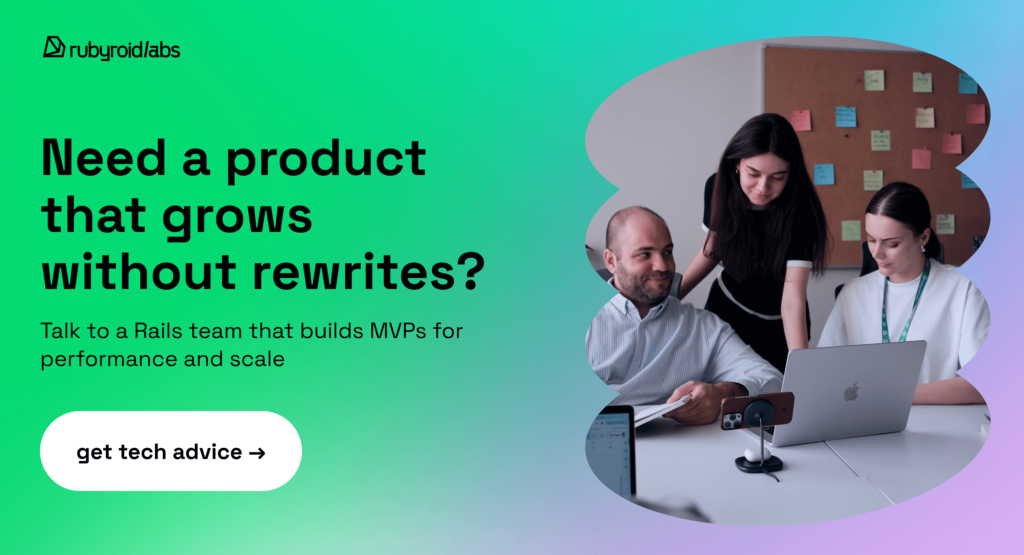Bringing a startup to market is high-pressure work: timelines are tight, stakeholders expect progress, and competitors move quickly. In that environment, you need a team and a tech stack that reduce risk, shorten feedback loops, and turn startup ideas into working software without unnecessary complexity.
Ruby on Rails is a strong fit for that mandate. Its conventions and “batteries‑included” toolkit help teams ship a functional MVP quickly, while a mature ecosystem of RoR gems and a large talent pool keep costs and onboarding time down. Beyond speed, Rails offers predictable structure, solid security defaults, and a smooth path from prototype to production, so you can keep iterating on the same codebase as you validate your product.
In this article, we’ll explore why Ruby on Rails works well for MVPs, its strengths and limitations, and the kinds of products it suits, so you can choose a stack that supports both a fast launch and sustainable growth.
Contents
- What Startups Need for MVP Development and How Rails Delivers
- Why Ruby on Rails is Good for MVP Development
- Ruby on Rails for Startups: Benefits and Built-In Tools That Supercharge MVP Development
- RoR Potential Limitations (And How to Solve Them)
- Real-World Examples of Startups That Used Rails
- Final Words
What Startups Need for MVP Development and How Rails Delivers
Having a brilliant concept alone doesn’t guarantee market victory. Unfortunately, many startups fail every year, and frequently due to a lack of product–market fit, technical limitations, or launching too late.
To stay in the game, you need something people actually want, that you can build fast, and that won’t buckle when you scale or pivot. That comes down to making smart tech decisions from day one.
At Rubyroid Labs, we build MVPs that are lean but never fragile. The goal is a solid base that welcomes real users, real feedback, and real change without falling apart.
Let’s look at what every startup MVP needs to survive and grow and how Ruby on Rails delivers on each of those essentials.
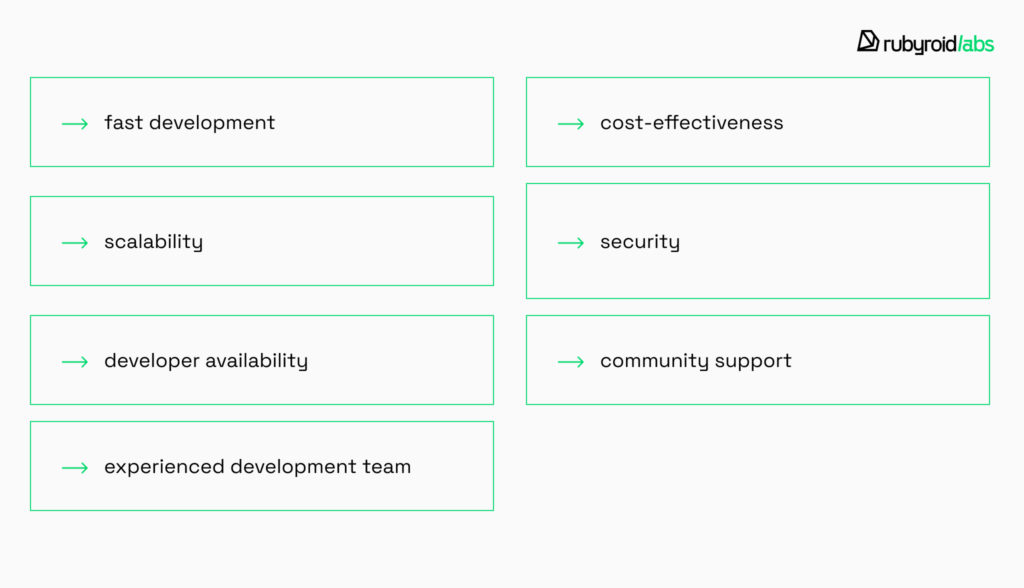
Fast Development
When you’re building a startup MVP, time isn’t just money, it’s momentum. Every week you’re not in front of real users, the window shrinks: investors get antsy, competitors close the gap, and your feedback loop grinds down.
Ruby on Rails is built for that kind of urgency. It helps teams move fast without resorting to duct tape. So much comes out of the box, like sane RoR defaults, generators, and batteries-included tools for routing, database migrations, form handling, and user authentication so you can spend your energy on what makes your product unique.
Cost-Effectiveness
Every hour of startup development counts, and every feature built needs to push the product closer to launch or learning. Wasted time is wasted budget.
Ruby on Rails makes budgeting easier by streamlining the build. Its conventions and automation tools cut a ton of boilerplate, so developers ship features faster. Faster cycles mean fewer hours and you don’t need a big team to ship the MVP. A small, sharp RoR crew can rival the output of a much larger stack, helping you launch sooner without overspending.
Scalability
An MVP should be small but not limiting.
With Ruby on Rails, you can launch quickly and keep growing the same codebase. Its MVC, model-view-controller, structure keeps things organized, so new features slot in cleanly without breaking what’s already there.
RoR is well-suited for moderate- to high-traffic applications, so whether you want to add new features, connect to more services, or handle thousands of users, Rails can scale with you without requiring a complete rewrite of your app.
Security
Security isn’t something you can add later. Even your first 10 users expect their data to be safe. Get it wrong early, and you risk losing trust before you’ve even found traction.
Ruby on Rails takes a secure-by-default approach. It protects against common threats like XSS, CSRF, and SQL injection right out of the box. Passwords are also handled safely using trusted libraries like bcrypt, with no need to write your own encryption.
Developer Availability
When you’re moving fast, the last thing you need is a talent bottleneck. The good news: RoR has nearly 20 years of history and a large, active, global community, so finding skilled developers is rarely a struggle.
Community Support
When building fast, getting stuck can kill momentum. Luckily, the RoR community is huge, experienced, and super active. Whatever problem development teams are facing, someone’s probably already solved it and shared the solution in a blog post, gem, or Stack Overflow answer.
Experienced Development Team
Having skilled developers makes a noticeable difference in both speed and quality. Experienced teams understand common challenges, make thoughtful architectural choices, and write code that’s easier to maintain over time.
A seasoned Ruby on Rails team brings the advantage of building quickly while creating a foundation that can handle growth.
At Rubyroid Labs, we’ve helped over 250 ideas become real, successful projects through our Ruby on Rails development services. Our talent pool includes RoR specialists with an average of 3 to 12 years of experience.

Why Ruby on Rails is Good for MVP Development
Building the initial version of a product demands both speed and clarity. Ruby on Rails stands out as a startup-friendly technology that enables young projects to advance rapidly while concentrating on delivering functional, meaningful features from day one.
Rather than bogging teams down with complex setup procedures and countless configuration choices, Ruby on Rails provides a straightforward development path. It offers intelligent defaults, robust built-in functionality, and an extensive ecosystem that eliminates much of the uncertainty.
While our recent article examines the technical comparisons of RoR vs other frameworks in detail, this discussion centers on what truly counts during startup MVP development: how RoR enables teams to develop more efficiently, validate concepts earlier, and maintain focus on elements that genuinely advance the product.
The following Rails features and principles contribute to streamlined startup MVP development:

Convention Over Configuration
Picture trying to cook in someone else’s kitchen where nothing is where you’d expect it to be. You’ll eventually find everything, but you’ll spend more time searching than cooking.
- With RoR: Ruby on Rails removes the guesswork from development setup. It provides a clear roadmap and suggests proven approaches. RoR comes with sensible defaults, allowing things to function seamlessly without extensive configuration work.
Don’t Repeat Yourself (DRY)
When the same thing is done in multiple places, changes become a headache. You fix it in one place but forget it in another, and bugs pop up.
- With RoR: The Rails framework is designed to keep things efficient and centralized. Once a rule or logic is defined, it applies throughout the project, saving time, reducing errors, and making updates easier.
Everything You Need Is Included
Some technologies often require picking and connecting dozens of tools. It’s like building a kitchen by buying every fork, pot, and knife separately.
- With RoR: Ruby on Rails gives you a full toolkit from the start, such as a database, testing, security, admin panels, and more.
Rapid Prototyping
Now that you need to test your idea with stakeholders and potential users, development speed is vital. However, some tools slow you down with endless setup and manual work.
- With RoR: Ruby on Rails is built for speed. Developers can launch working features like a booking system or user dashboard in days, not weeks.
Huge Library of Add-ons (RoR Gems)
Features like login, payments, or admin dashboards can take weeks to build from scratch.
- With RoR: Thanks to a massive ecosystem of plug-and-play tools (called “RoR gems”), your Ruby on Rails team can add complex features quickly.
We’ll explore the particular built-in features and gems that fuel this fast development approach and explain how they position Ruby on Rails ahead of competing frameworks for MVP building.
In short, during startup MVP development, Ruby on Rails allows teams to bypass configuration delays, minimize repetitive tasks, and prioritize building genuine features at greater speed. When developing an MVP, this efficiency and ease of use frequently separates successful launches from projects that lose momentum.
Ruby on Rails for Startups: Benefits and Built-In Tools That Supercharge MVP Development
Now let’s move on to the key advantages that explain why Ruby on Rails leaves other frameworks behind when it comes to building a minimum viable product.

What Are The Benefits of Ruby on Rails for Startups?
Security by Default
Ruby on Rails has always prioritized security, and with each version, it gets even better. With Rails 8, security features are baked in more deeply than ever, giving your team a solid foundation without extra configuration.
- Why we recommend it for startup MVPs: You don’t need to worry about vulnerabilities from day one. Developers can focus on building the product, while Rails quietly takes care of the basics like protecting against SQL injection, CSRF, and XSS attacks.
Full Stack in One Framework
Ruby on Rails was once purely backend, and now it’s full stack. With updates like Hotwire and Turbo, Rails lets developers build both backend and frontend using Ruby with no need to bring in a separate JavaScript frontend framework.
- Why we recommend it for startup MVPs: You can build an entire MVP with just one developer or a small team. That means lower hiring costs, faster development, and fewer moving parts.
Great Performance Without the Extra Baggage
Ruby on Rails supports SQLite, a lightweight and efficient database that’s well-suited for MVPs and small- to medium-sized applications. It requires minimal setup and handles typical product needs without the overhead of more complex systems.
- Why we recommend it for startup MVPs: You can get your product up and running quickly without dealing with advanced database configuration. It keeps development simple, reduces hosting costs, and performs well for most MVP use cases, allowing you to focus on building features, not infrastructure.
Key RoR Tools For Rapid MVP Development
RoR benefits from over 170,000 Ruby gems, offering everything from authentication and background jobs to file uploads and admin dashboards. We won’t cover them all but we will highlight the tools our in-house developers rely on most for MVP success.
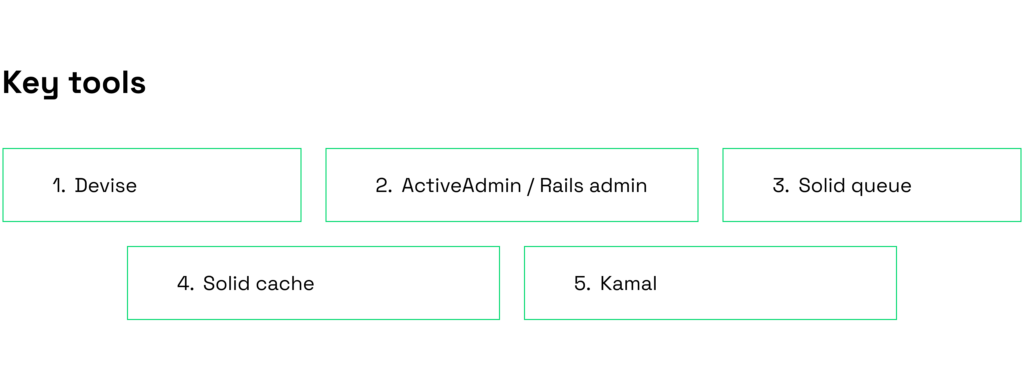
Devise Tool
Devise is a popular fast and secure authentication gem that handles login, registration, password recovery, and more.
- Why we recommend it for startup MVPs: Instead of building a login system from scratch, your RoR team can integrate Devise quickly with secure defaults. That saves days (or weeks) of development and ensures your MVP is user-ready from the start.
ActiveAdmin / Rails Admin
These RoR gems generate a fully functional admin dashboard for managing users, content, and settings.
- Why we recommend it for startup MVPs: You get a ready-to-use internal admin interface without spending time or budget on custom development. Essential for early-stage products that need internal tools fast.
Solid Queue
Solid Queue is a native built-in RoR tool for running background jobs (like sending emails or processing data behind the scenes).
- Why we recommend it for startup MVPs: Your app stays fast and responsive even when handling heavy tasks. You don’t need to integrate third-party job processors like Sidekiq, it’s all built in.
Solid Cache
Solid Cache is a native RoR tool for cashing. It improves performance by storing frequently accessed data, so your app doesn’t have to fetch it from scratch every time.
- Why we recommend it for startup MVPs: Faster page loads and a smoother user experience, especially for dashboards and data-heavy pages. It also reduces server costs and complexity.
Kamal
Kamal is a new simple and fast deployment tool from the creators of Ruby on Rails. It uses Docker and SSH to deploy your app to a remote server with just a few commands.
- Why we recommend it for startup MVPs: You don’t need a DevOps engineer to launch your MVP. One developer can build the frontend and backend, deploy, and update the app themselves, saving time, effort, and infrastructure costs. Perfect for lean teams.
Generally speaking, Ruby on Rails persistently absorbs excellent community developments and builds them into its core architecture. Instead of coordinating various third-party components, developers gain access to solid, integrated solutions that function perfectly from day one.
RoR Potential Limitations (And How to Solve Them)
Even the sweetest honey has its occasional bitter drop, so let’s play fair and explore what limitations Ruby on Rails actually has. When you’re transparent about these trade-offs, it leads to more thoughtful planning and better preparation for roadblocks you might encounter along the way.
These issues are typically solvable and usually only become relevant for larger projects as they scale. However, you should still know about them. For the majority of MVPs and growing businesses, these limitations rarely pose real-world problems.
Performance at Scale
When it’s time to make a big scale, an RoR-based application can face some difficulties. Due to certain reasons the app can encounter performance bottlenecks when handling massive traffic loads or computationally intensive operations. While Ruby on Rails excels at rapid development and moderate traffic, applications serving millions of users simultaneously may experience slower response times compared to compiled languages like Go or Java.
Solution:
Start with a Rails monolith for speed, then migrate performance-critical components to microservices when you reach actual scale issues. Most startups never hit these limitations, and by the time you do, you’ll have the resources to optimize strategically. More about monoliths vs microservices and Ruby on Rails, we covered this in our blog post on that topic.
Ruby on Rails App Can Use More Server Resources Over Time
Growing user bases and feature sets can cause your app to demand more memory resources, which may result in elevated hosting bills unless you optimize performance carefully.
Solution:
Choose affordable cloud hosting (like Heroku or Render) for your startup. And once your app begins to scale, your team can optimize how the app uses resources, such as cleaning up unused data, tuning background processes, or upgrading to more efficient servers. These are standard steps handled by experienced Ruby on Rails developers as part of your growth stage.
RoR Is Not Ideal for High-Speed, Real-Time Apps
If your entire product relies on ultra-fast, real-time interaction like a multiplayer game, stock trading app, or live auction system, Rails might not be the best tool for that kind of performance.
Solution:
If real-time is just one part of your app (like chat or notifications), Ruby on Rails can still be a great choice. You can build the main product in RoR and add real-time features using tools like Hotwire or external services.
If your entire product depends on real-time performance, it’s better to consider other tech stacks like Elixir or Node.js that are built for that use case.
Learning Curve for New Developers
Developers encountering Ruby on Rails for the first time can feel overwhelmed by its “convention over configuration” approach and highly opinionated design choices. The “magic” that RoR performs automatically often leaves newcomers puzzled, as these hidden mechanisms aren’t immediately transparent or understandable.
Solution:
RoR’s extensive documentation, active community, and consistent conventions actually accelerate learning once developers understand the patterns. The initial investment in learning Ruby on Rails conventions pays off with dramatically faster development speed.
What may seem like limitations in Ruby on Rails are simply part of the learning curve, not obstacles. Experienced RoR teams understand how to work within Rails’ boundaries while maximizing its strengths. They know when to optimize for performance, how to use Rails conventions to their advantage, and how to architect scalable solutions right from the start. Success with Ruby on Rails comes down to partnering with developers who truly understand the framework inside and out.
If you want to discuss how our team approaches these challenges or have specific concerns about Rails for your project, our tech squad is ready for a free consultation and available to hire to develop your RoR MVP.
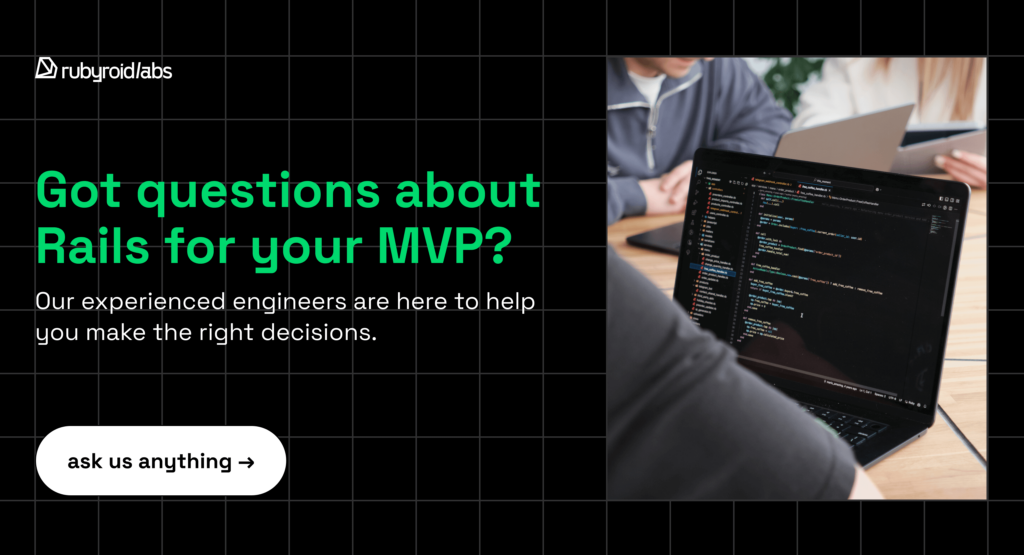
Real-World Examples of Startups That Used RoR
Many well-known startup MVPs began their journey with Ruby on Rails. Below are examples across different industries where Ruby on Rails helped project owners move quickly, validate ideas early, and grow into successful businesses.
Let’s go by industries and see the brightest of them.
CRM & Business Management
Using Ruby on Rails, Day One Credit created an MVP linking customers who can’t qualify for standard auto loans with California bankruptcy car loan providers. The RoR platform automates management tasks and achieved 20 sales within 2 months, all before launching marketing campaigns.
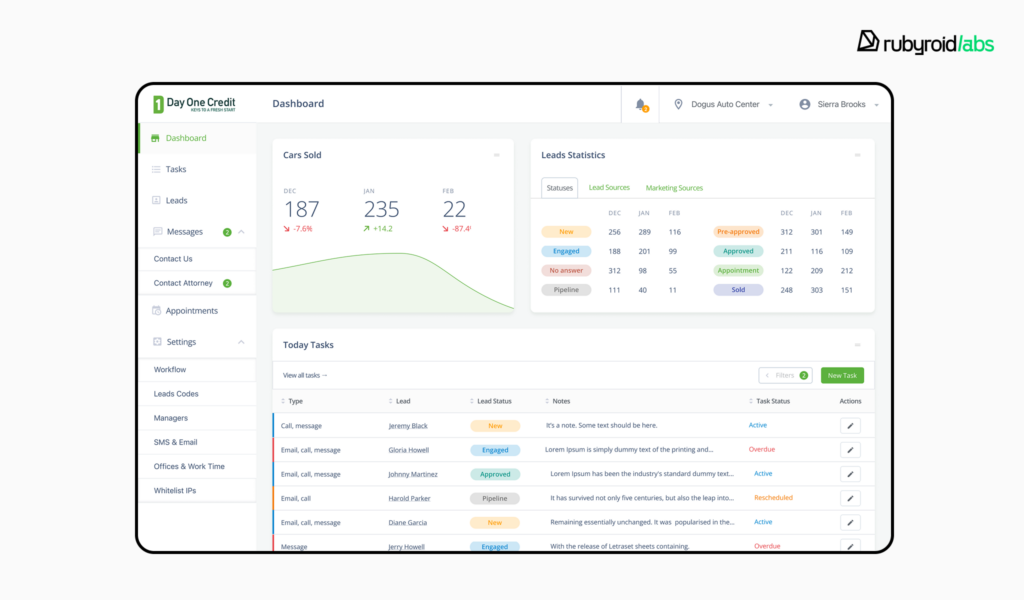
E-commerce & Marketplace
The global marketplace for handmade and vintage items Etsy built their initial platform on Ruby on Rails, enabling millions of creative entrepreneurs to sell their products worldwide.

Insurance Platform
Another startup MVP example is CoverageXpert. It’s an online hub for commercial insurance product details, helping brokers, clients, and legal experts better understand policy terms and conditions. Built with Ruby on Rails, it comes equipped with powerful PDF processing, Google OCR, and AI-driven tools like ChatGPT and Gemini to analyze coverage. The MVP was completed in just 3 months and is now used by enterprise‑level B2B customers.
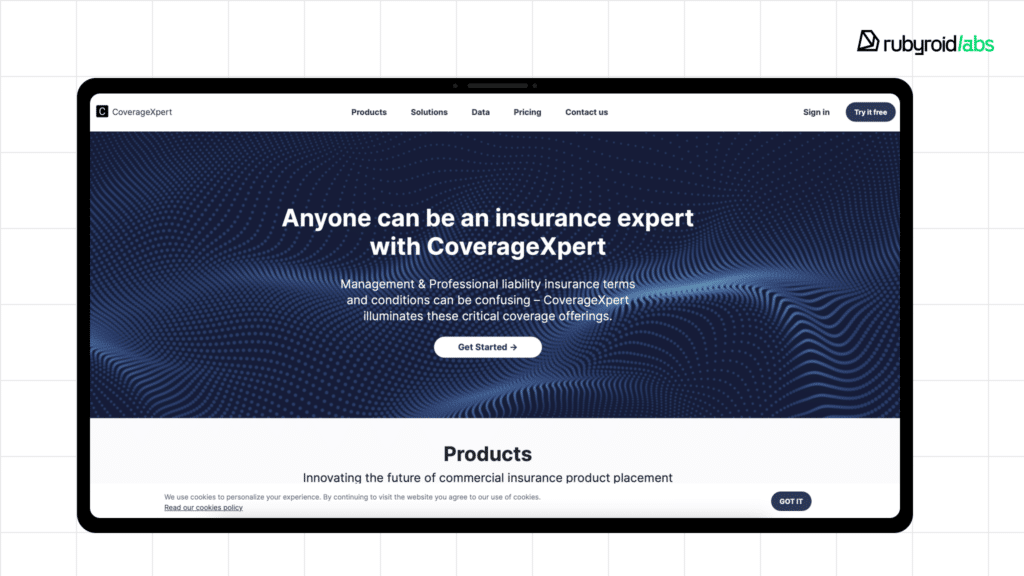
Social Media & Communication
The creative community platform for designers Dribble used Ruby on Rails to build their portfolio-sharing and networking features. Rails enabled quick development of complex social features like following, commenting, and showcasing creative work.

Big ideas can start small, but with the right vision and the right dedicated Ruby on Rails developers, they can grow fast, scale wide, and become products that users can’t get enough of.
Final Thoughts
Ruby on Rails is a proven framework with its own interesting structure and features for building a minimum viable product and testing it with your stakeholders and users.
The framework is exceptional because it provides:
- fewer technical decisions
- faster development using proven tools
- lower costs thanks to full-stack capabilities
- built-in security, caching, deployment, and background processing
Plus a huge ecosystem of RoR gems with many essential tools now natively supported, Rails removes the complexity that typically slows down early-stage development.
As you can see from the project examples we shared, these didn’t just launch quickly but grew successfully because Ruby on Rails gave them the solid foundation they needed for growth.
But here’s the thing: the most important factor in any successful Rails project isn’t just the framework itself; it’s having a strong team and deep knowledge to rely on. The right RoR development team makes all the difference between launching quickly with a solid foundation versus getting stuck in endless development cycles or building something that just won’t scale.
When you choose Ruby on Rails, you’re not just picking a technology but partnering with a mature ecosystem backed by experienced developers who really know how to turn your idea into a thriving business.
